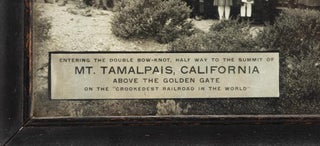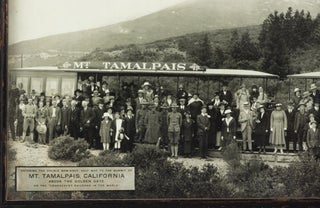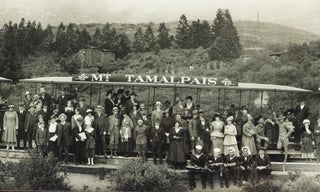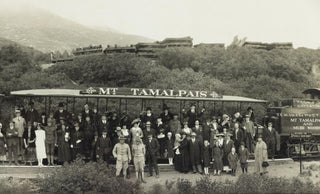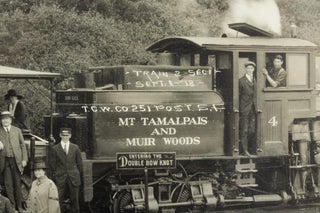ORIGINAL PANORAMIC PHOTOGRAPH OF A 1918 OUTING ON THE MOUNT TAMALPAIS AND MUIR WOODS RAILWAY. San Francisco: Theodore C. Wohlbruck, 1918. Silver gelatin print, 17x72 cm (6.75 x 28.5 inches) Captioned at lower left within the photograph, "Entering the double-bow knot, half way to the summit of Mt. Tamalpais, California above the Golden Gate on the 'Crookedest Railroad in the World.'" An early California photograph by Wohlbrück taken from the beginning of the famous "double bow knot" trackage from Mill Valley to The Tavern of Tamalpais (the mountaintop tavern and the summit of the east peak can be seen in the background). "The Mount Tamalpais & Muir Woods Railway was a scenic tourist railway operating between Mill Valley and the east peak of Mount Tamalpais in Marin County, California, covering a distance of 8.19 miles (13.18 km), with a 2.88 mile (4.63 km) spur line to the Muir Woods. The railroad was incorporated in January 1896, and closed in the summer of 1930 ... Billed as the 'Crookedest Railroad in the World,' the line was renowned for its steep and serpentine route, winding through picturesque terrain to a mountaintop tavern providing first-class hospitality and panoramic views of the San Francisco Bay Area. Despite its popularity, the railway met its demise following a fire in 1929, and dwindling ridership when the automobile could finally drive to Tamalpais' summit" (Wikipedia). "In 1900, when he was twenty-two years old, Theodore Clemens Wohlbrück (1879–1936) moved to Worcester, Massachusetts, from New Jersey and started a career as a photographer. He specialized in city views that were often turned into postcards and also took class photographs of children for schools. He opened a modest photo studio on Main Street and married a local girl in 1902. By 1910, Wohlbrück had grown tired of his life in Worcester and moved west; first setting up a studio in Reno, Nevada, and later permanently settling in California. In addition to continuing his photography business (which now focused on western scenery), he also started other projects -- including operating a series of souvenir shops and gas stations in the Sierra Nevada along the route of the ill-fated Donner Party, and opening a museum of transportation built around his large collection of horse-drawn vehicles and early automobiles" (American Antiquarian Society). "In Massachusetts he learned the art of photography and saw a niche to fill by traveling from school to school taking class pictures. Getting a divorce in Reno brought him to the West in 1912 where he remarried. He continued to travel from school to school in California taking class pictures but he also looked for other opportunities. The automobile was becoming popular and with it, auto travel. Automobiles did not travel the roads of the day very rapidly or very reliably. T. C. could see they needed services and their drivers needed refreshment. So he opened some of the first “Quick Marts,” a series of “canteen service stations.” His first one was at Emigrant Gap where P.G.&E. had placed a lookout so people could see the Spaulding Dam construction. The second was at Echo Summit and the third was at the Pioneer Monument (now Donner State Park) in Truckee. Class photography probably takes a skill to get energetic youngsters to pose for group portraits where all the students look good at the same time. Technically, though, it’s day-to-day work. T. C. clearly saw more potential in photography than just class pictures. He began traveling California recording what he saw and sold the resulting photographs as postcards in his 'canteen service stations.' Those postcards are the fascinating legacy of day-to-day life in the 1910’s and 20’s" (Donner Summit Historical Society, The Donner Summit Heirloom, November 2012, issue 51). An excellent image. Frame rubbed. Wohlbrück's western panoramas are uncommon and are rarely offered for sale. (#166362).
Price: $1,250.00
"Coming Soon"



